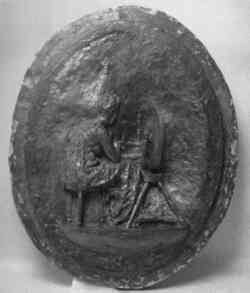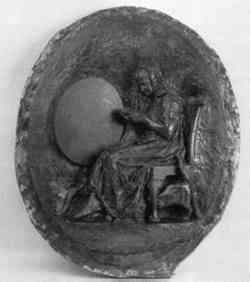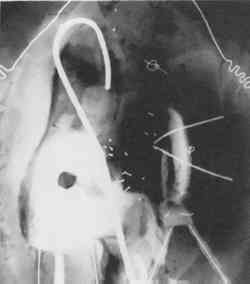Examination, Technical Analysis, and Treatment of His Works in the Charles Bregler Collection of the Pennsylvania Academy of the Fine ArtsMARK F. BOCKRATH, VIRGINIA N. NAUD�, & DEBBIE HESS NORRIS
3 THE SCULPTURE OF THOMAS EAKINSVIRGINIA N. NAUD� The known body of Thomas Eakins's sculptural work includes no more than 50 unique images and falls into 3 distinct categories, each of which is represented by works in the Bregler Collection. Eakins created three-dimensional sketches for paintings, polychromed anatomical casts, and relief sculpture. He worked in wax, clay, and plaster. 3.1 EAKINS'S THREE-DIMENSIONAL SKETCHESAmong the three-dimensional sketches are five plasters in the Bregler Collection that document the working process for Eakins's William Rush Carving His Allegorical Figure of the Schuylkill River (1876–77, Philadelphia Museum of Art).The five original wax figures from which the Bregler sketches were made are at the Philadelphia Museum of Art. They are modeled on wooden bases over armature using a hard red wax. Dark red paint covers figure and base. Knife cuts in the wax mark the places where a gelatin mold was released, and mold material remains in many crevices. The sketch of William Rush's head, was modeled with reference to Rush's terracotta self-portrait at the Pennsylvania Academy of the Fine Arts. For the other small figures, Eakins referred to Rush's public work prominently displayed around Philadelphia. 3.2 EAKINS'S ANATOMICAL CASTSThe plaster anatomical casts were made for teaching. Dissection was offered as part of the art school curriculum, and Eakins frequently took gelatin molds from cadavers to preserve the anatomical information revealed during course work. Eakins and his students painted the casts with various colors to emphasize the information on them: red for muscles, yellow for tendons, brown for skin, and white for bone. A neck and foot in the Bregler Collection are representative of the genre of anatomical casts, and the neck carries the typical Latin nomenclature painted on the polychromed surface with Eakins's characteristic block lettering. 3.3 EAKINS'S RELIEF SCULPTUREThe first two groups of sculptural work serve study or instructional purposes. The last group, relief sculpture, was created for presentation and In the reliefs (figs. 1–2), those familiar with Eakins's paintings and photographs will recognize his attention to the activities of everyday life, his technical interest in detail and sharp focus, and his eagerness to develop compositions that challenged him to solve problems of perspective. The rendering of a tilt-top table seen in Knitting, as well as in numerous sketches and paintings is discussed in Eakins's unpublished writing “Sculptured Relief.” In this manuscript at the Philadelphia Museum of Art, which he drafted and reworked for his own use as lecture notes, Eakins attempted to develop a mathematical system to guide perspective rendering in shallow and high relief.
Many scholars have written about Eakins's labors to execute the commission for Spinning and Knitting. They were to be realized as stone carvings on a chimneypiece in the Philadelphia townhouse of James P. Scott. The artist's dedication to the project and his devastation in the face of the client's rejection of his work are well known (Turner 1983, 165–70; Foster and Liebold 1989), 155. Eakins valued the reliefs, exhibited them, and later had them cast in The Bregler reliefs are believed to be originals of all the other known versions for several reasons. First, integral to each relief, on the back and around the sides, is auxiliary plaster that appears to serve as part of a mother mold. The large wires and unexplained voids and irregularities in the auxiliary material confuse reading of the x-radiographs (figs. 3–4). The relief and mold faces are coated with shellac, indicating that the works were prepared to be used in casting. Second, the Bregler reliefs are not plaster casts but are assemblages, composed of separate pieces, surfaced and painted for presentation. All the other known replicas are casts; all have the same dimensions, allowing for bronze shrinkage. Third, details of fillings around the border of Spinning show clear contrast of texture on the Bregler relief and only subtle contrast on the recasts.
The border for Spinning was added by Eakins during the working process. In the x-radiograph (fig. 3), dowels of a less dense material can be seen above the hanging wire on the left. These dowels continue around the relief, joining an outer oval to a central oval image. The border enlarged Spinning and gave it the same outside dimensions as its companion Knitting. The image of the woman spinning was intentionally rendered smaller than the Spinning appears to be assembled from a number of components. The x-radiograph shows armature in the two projecting legs of the spinning wheel and in all three legs of the stool. The armature is unnecessary considering the shallow relief plane in which these design motifs rest or the support they receive from adjacent material. It appears that the armature was necessary for modeling these motifs in three dimensions and that they were later reduced to relief as Eakins reworked them into the composition. Three recasts of Spinning from Eakins's studio have a wire in the central projecting leg of the stool or have no armature at all. X-radiographs of casts of Spinning from the Philadelphia Museum of Art and the Art Institute of Chicago show the single wire. A privately owned cast was damaged extensively and showed no metal in the area of the stool. There is no armature in the wheel, which is rendered in high relief and had suffered damage. There are, however, a number of very small nails or wires under the painted surface. The wires are too thin to show up on the x-radiograph but they may have been of structural use as the wheel was being assembled. Further indications of the artist's manipulation of sculptural components were seen after removal of the single campaign of repair and retouching, discussed below. The figure of the woman appears to have been placed into the sculptural plane. A mold mark on her neck might suggest that she was cast from an earlier study. Interruptions in the plaster behind her back and in front of her neck are evident. A spongy filling material was found in patches around her form. The artist used the same material in a large filling at the top and a small filling at the bottom of the border. Under ultraviolet light, these fillings appeared green, indicating the presence of natural resin. A sample from the patch on the top of the border was identified by optical microscopy and microchemical analysis as crushed noncalcined bone in a resin varnish binder. Although there is painstaking attention to detail on the figure and spinning wheel, the background is modeled very loosely. Samples were not taken below the relief surface, so that the materials the artist used to secure and make transitions between the assembled components remain unidentified. Familiar materials such as clay or wax may have been used as well as the filling material identified on the surface. The background may have been built directly in plaster during the final stages to prepare a painted surface for presentation to the client. Eakins intended this object as the first form of a process. He was not aware that he would be asked to suddenly cease his labor when he had completed the pieces now known as the Bregler reliefs. He intended to have them cast in bronze and to use the bronze versions as models for a stone carver (Foster and Leibold 1989), 155, letter 62. In the relief Knitting, one observes the similar phenomenon of an assembled work. The table top has been placed on the relief surface as a separate element. The cat was most likely modelled separately and later positioned underneath the chair. It is fully supported by armature, although its placement on the surface clearly does not require auxiliary support. It appears that during work on this original piece Eakins may have set “knitting needles” into the hands of the figure, consistent with his desire to Samples from both reliefs studied in cross section show a layering pattern that suggests three working stages in the artist's studio and one campaign of restoration. Samples were examined using polarized light microscopy and microchemical analysis (Gill 1991). Working upward, the layers were identified as (1) plaster; (2) slightly pigmented varnish; (3) grime; (4) slightly pigmented varnish; (5) thin, clear varnish; (6) grime; (7) shellac; (8) grime; and (9) retouch paint in spots. Pigments identified in the varnish layers were ivory black, red ochre, yellow ochre, burnt sienna, zinc yellow, and chrome yellow. 3.4 CONSERVATION TREATMENTThe 1989 conservation of Knitting and Spinning involved removal of superficial grime and overpaint from the generally stable shellac layer. The thick overpaint was consistent in texture and solubility. In areas of deterioration or damage, it was applied in numerous layers. A thin barrier coating of Acryloid B 72 was applied to the clean shellacked surface. A filling paste was made from acrylic latex caulk (Dap brand) and microspheres (West Systems 409). On Knitting, the filling paste was used to adjust the previous restoration of the cracked table top. On Spinning, it was placed in the background behind the figure spinning, where spongy original fillings had apparently crumbled away, and on the damaged projection of the spinning wheel. On both reliefs, scattered voids from large chips were filled. Wherever final tooling was necessary, the filling was surfaced with Polyfilla. All new material was toned with acrylic paint. |



